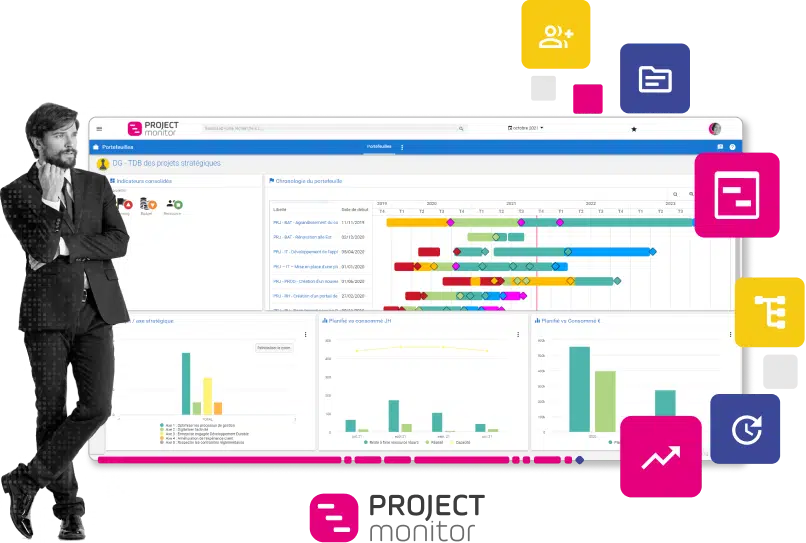How do you track and manage project progress?
Monitoring and controlling the progress of projects in a project portfolio is an essential element in ensuring efficient management and successful achievement of your objectives.
This task can be simplified by using clear monitoring and steering practices adapted to the portfolio context!
By keeping control of the progress of your projects, it becomes easier to monitor progress, identify any deviations from targets, and take corrective action.
Simple, effective tracking will enable you to gain an overview of the portfolio's progress, make informed decisions, ensure transparent communication with stakeholders and maximize overall project portfolio performance.
Find out more in this article:
- 5 tips for simply managing project progress and delivering on time
- The benefits of project portfolio software for monitoring project progress
- Practical examples of project management success stories
What is the purpose of the progress report?
The main purpose of the progress report is to provide a clear and concise view of a project's status at a given point in time.
This report enables :
- communicate to stakeholders progress made, problems encountered and actions taken to achieve project objectives,
- detect deviations from initial plans,
- identify potential risks,
- and make appropriate decisions to ensure the project's success.
In short, the progress report plays an essential role in providing a global and objective picture of the project's status, facilitating communication, decision-making and effective project management.
How can I review progress?
5 tips for simply managing project progress and delivering on time!
Here are a few best practices to help you manage the progress of your projects:
- Define clear objectives
- Plan and set milestones
- Perform regular reviews
- Check that teams are not over-staffed
- Identify and analyze risks
Define clear objectives
Set specific, measurable, achievable, relevant and time-bound (SMART) objectives. These objectives will serve as a benchmark against which to measure progress. A roadmap is a strategic planning tool used to give you a visual representation of the milestones and objectives to be achieved in a project, initiative or strategy. It's a document that sequentially presents important milestones and steps, usually over a given period of time. A roadmap provides an overview of the project or initiative, enabling stakeholders to understand the path ahead, the key milestones and the dependencies between them.
Discover an example of a digital roadmap
Plan and set milestones
Draw up a detailed project plan, identifying key stages and milestones. This will enable you to easily monitor progress and check that deadlines are being met. A " milestone " is a key moment in the project when a verifiable intermediate result is delivered. For example, the delivery of the final version of a specification. The big advantage of milestones over tasks is their simplicity. A milestone is either reached or not! There are methods for defining a relevant milestone plan at the start of a project.
In milestone-based project management, the project review consists of validating whether a milestone has been passed or not. In the latter case, it is necessary to define the estimated date of passing. This follow-up provides non-subjective, verifiable and shared information on project progress. Several indicators can be calculated using milestones to measure theprogress or delay of a project. For example, the percentage of milestones actually passed compared with the target percentage. Or tracking the milestone that is driest.
Perform regular reviews
Maintain open and regular communication with project team members and relevant stakeholders. Hold frequent follow-up meetings to discuss progress, problems encountered and corrective actions to be taken. These can be project reviews, or more strategic project portfolio reviews.
Check that teams are not over-staffed
Resource management capability and over-staffing (or over-allocation of resources) are challenges important in project management. Over-staffing can compromise project planning, as resources may not be available when required. This can lead to delays, schedule adjustments and a loss of flexibility to cope with changes or new demands.
Identify and analyze risks
Identify potential risks at the outset of the project and implement appropriate mitigation measures. Monitor risks throughout the project and adapt your approach accordingly.
Use tracking tools
Use project management tools such as Gantt charts, dashboards or task tracking tools to visualize and track project progress. These tools enable you to see which tasks have been completed, which are in progress and which are still to come. Project portfolio management software such as Project Monitor is particularly well suited to tracking the progress of portfolio projects.
By following these principles, you'll be able to manage the progress of your projects efficiently, while keeping a clear overview of their progress.
What type of progress meetings should be set up to monitor project progress?
To monitor project progress effectively, we recommend setting up two types of meeting: regular progress meetings and comitology meetings. Here's how to organize these meetings:
Regular progress meetings
These meetings are designed to monitor the progress of projects on a regular basis, usually weekly or monthly.
They enable project team members to share :
- updates,
- progress,
- obstacles encountered
- and planned actions.
Comitology meetings
Comitology meetings are periodic meetings involving key project stakeholders, such as sponsors, project managers, functional managers and representatives of the various stakeholders.
The purpose of these meetings is to :
- provide an overview of the project's progress,
- assess risks,
- make strategic decisions
- and solve major problems.
They ensure effective coordination, aligned decision-making and a global view of project performance.
What tools are available for planning and monitoring project progress?
There are many tools available for planning and steering a project, and they can vary according to the specific needs of the project and the preferences of the organization. Here are some common examples of planning and steering tools:
- Gantt chart : This is a visual tool that represents the various project tasks on a time scale. It allows you to plan, monitor and visualize the dependencies between tasks, the key dates and the duration of each activity.
- Dashboard : This is a tool that groups together the project's key performance indicators (KPIs), such as progress, deadlines, costs, quality, etc. The dashboard provides an overview of the project's status, and enables you to monitor performance and trends.
- Task management and collaboration tools: Tools such as Trello, Jira or Microsoft Planner make it easy to create to-do lists, assign responsibilities, monitor progress and encourage collaboration between project team members.
- Risk management tools: Risk management tools help to identify, assess and manage project risks, providing risk monitoring and mitigation capabilities.
The choice of planning and control tools will depend on project characteristics, complexity, team size, available resources and organizational preferences. Select the appropriate tools that facilitate effective project management and meet your organization's specific needs.
Project portfolio management software lets you easily monitor the progress of projects in your portfolio.
Project portfolio management software such as Project Monitor offers advanced planning, resource management, cost tracking and detailed reporting on project progress.

There are many advantages to using project portfolio management software to track project progress efficiently. Here are just a few reasons why using such software is recommended:
- Centralized information: Project portfolio management software enables all project information to be centralized on a single platform. This facilitates access to up-to-date data, reduces the dispersal of information and enables more consistent management of project progress. The software provides real-time visibility of project status.
- Tracking key performance indicators: Project portfolio management software enables you to easily track key performance indicators, such as on-time delivery, budget compliance, stakeholder satisfaction, etc. These indicators help you to assess project progress, identify deviations from objectives and take the necessary corrective action. These indicators help you to assess project progress, identify deviations from targets and take the necessary steps to correct them.
- Improved collaboration and communication: Project portfolio management software promotes collaboration between project team members, stakeholders and managers. They offer features for information sharing, feedback, task tracking, document management and more. This facilitates communication, enhances transparency and improves coordination between the various parties involved in projects.
Kanban
The Kanban from Project Monitor simplifies teamwork. This feature not only provides a project view, but also a "multi-project" and "multi-user" view.
- Collaborate anywhere, plan your workflows and easily spot bottlenecks
- A single or multi-project vision
- Identify the volume of your teams' unfinished business
Facilitate teleworking and energize your teams with the Daily Meeting!
Online Gantt
Which milestone is done? Which milestone is overdue? Compare schedule target, schedule revised and schedule completed in just one click.
Project Monitor software uses a Gantt chart to manage schedule. This is the project manager's visual management tool par excellence! It shows what needs to be done along a time axis. The Gantt was already interactive, equipped with all the key functionalities for managing a schedule. The advantages of the Project Monitor Gantt:
- The whole project team works together in real time to monitor and update project progress.
- Easily identify project dependencies and progress rates
- Visualize and anticipate project drifts and compare the schedule target and the revised schedule in one click.
Reporting tools
Project Monitor 's reporting tools and dashboards provide you with analytical reports and summaries of your organization's activities and results.
- Project follow-up
- Budget monitoring
- Resource tracking
- Risk monitoring
- Cost tracking
💡 At Bornes Solutions, Project Monitor enabled the PMO to set up key project "deliverability" indicators:
- Number of terminals installed
- Number of terminals being installed
- Number of terminals planned for installation
The implementation of Project Monitor has also been part of a continuous process improvement approach, enabling sticking points to be identified and corrected as and when necessary. Data interpretation has enabled the creation of key project performance indicators such as :
- Average project duration
- Number of projects managed per project manager
- Number of projects by type
- Identifying project complexity
How do I create a tracking table?
It's important to choose a format and structure suited to your specific needs. As well as ensuring that the chart is regularly updated to reflect the current status of projects. This will enable you to effectively monitor the progress of your projects, identify potential problems and take corrective action accordingly.
In the Project Monitor"toolbox", the Report Center provides a library of customized dashboards.
Project Monitor dashboards are designed to be customizable and integrated into your governance processes.
Dashboards, calculated in real time, offer all key project indicators. Such as budget, resource and risk monitoring.
Practical examples of project management success stories

Hauts-de-Seine Habitat, a single platform for managing all projects: strategic, construction, renovation, digital, etc.

Interview with Bornes Solutions on project KPIs. Discover how the implementation of a PPM approach and the use of Project Monitor software have enabled Bornes Solutions to secure the deliverability of its projects in a context of strong growth.

Highlights of the Ille et Vilaine local authority's experience during a webinar in partnership with Virage Group , on the theme of digital transformation.